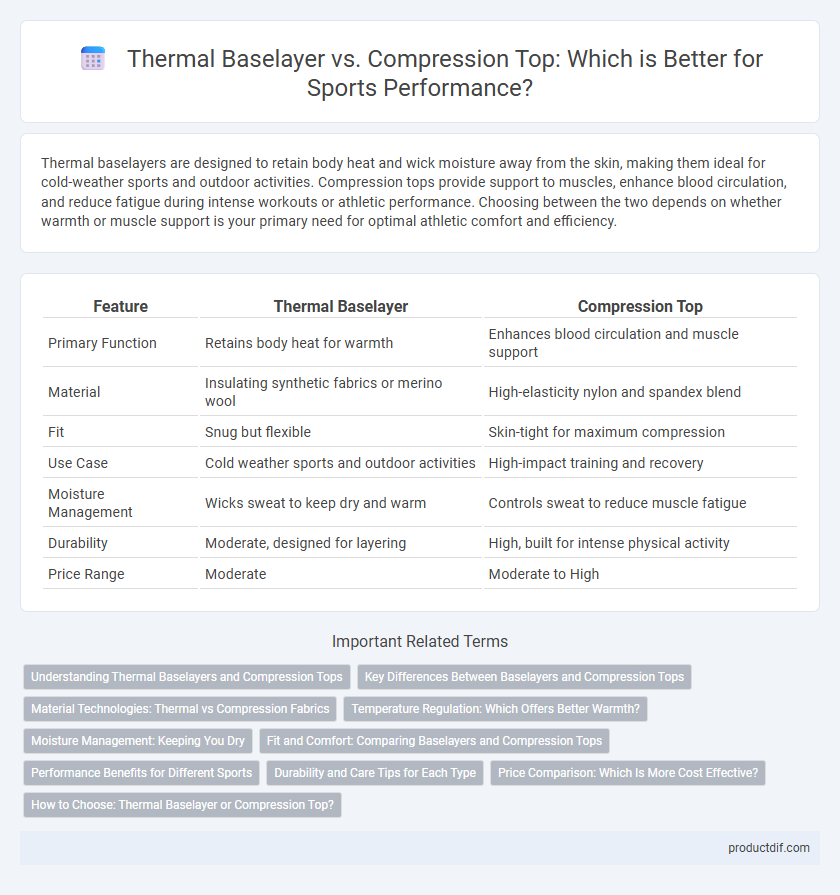Thermal baselayers are designed to retain body heat and wick moisture away from the skin, making them ideal for cold-weather sports and outdoor activities. Compression tops provide support to muscles, enhance blood circulation, and reduce fatigue during intense workouts or athletic performance. Choosing between the two depends on whether warmth or muscle support is your primary need for optimal athletic comfort and efficiency.
Table of Comparison
| Feature | Thermal Baselayer | Compression Top |
|---|---|---|
| Primary Function | Retains body heat for warmth | Enhances blood circulation and muscle support |
| Material | Insulating synthetic fabrics or merino wool | High-elasticity nylon and spandex blend |
| Fit | Snug but flexible | Skin-tight for maximum compression |
| Use Case | Cold weather sports and outdoor activities | High-impact training and recovery |
| Moisture Management | Wicks sweat to keep dry and warm | Controls sweat to reduce muscle fatigue |
| Durability | Moderate, designed for layering | High, built for intense physical activity |
| Price Range | Moderate | Moderate to High |
Understanding Thermal Baselayers and Compression Tops
Thermal baselayers provide superior insulation by trapping body heat through materials like merino wool and synthetic fibers, making them essential for maintaining warmth during cold-weather sporting activities. Compression tops enhance blood circulation and muscle support by applying targeted pressure, which can improve performance and reduce muscle fatigue during intense exercise. Choosing between thermal baselayers and compression tops depends on whether warmth or muscle stabilization is the primary need for the athlete.
Key Differences Between Baselayers and Compression Tops
Thermal baselayers are designed primarily for insulation and moisture-wicking, maintaining body heat during cold weather activities, while compression tops focus on muscle support and enhanced blood circulation to improve performance and reduce fatigue. Baselayers typically feature lightweight, breathable fabrics to regulate temperature, whereas compression tops use tight-fitting, elastic materials that apply graduated pressure. Athletes choose baselayers for warmth and comfort, and compression tops for performance enhancement and recovery benefits.
Material Technologies: Thermal vs Compression Fabrics
Thermal baselayers utilize advanced synthetic fibers such as polyester blends and merino wool engineered with moisture-wicking and insulating properties to retain body heat in cold conditions. Compression tops employ high-elastane fabrics like spandex and nylon designed to improve blood circulation, enhance muscle support, and reduce fatigue through targeted pressure zones. Both fabric technologies integrate breathability and stretchability, but thermal materials prioritize heat retention while compression fabrics focus on performance enhancement and recovery.
Temperature Regulation: Which Offers Better Warmth?
Thermal baselayers excel in temperature regulation by trapping body heat through insulating fabrics like merino wool or synthetic blends, ensuring consistent warmth during cold weather activities. Compression tops, while offering muscle support and moisture-wicking properties, provide less insulation and are primarily designed for enhanced blood circulation rather than heat retention. For optimal warmth in sporting conditions, thermal baselayers outperform compression tops by maintaining a stable microclimate close to the skin.
Moisture Management: Keeping You Dry
Thermal baselayers excel in moisture management by wicking sweat away from the skin and providing insulation to maintain body heat in cold conditions. Compression tops use tight fabric to enhance blood flow and wick moisture efficiently, promoting quicker evaporation during intense workouts. Both options prioritize keeping you dry, but thermals are better suited for retaining warmth, while compression tops enhance breathability and moisture control in high-performance activities.
Fit and Comfort: Comparing Baselayers and Compression Tops
Thermal baselayers offer a snug, flexible fit designed to trap body heat and wick moisture, ensuring warmth and comfort during cold-weather activities. Compression tops provide a tighter, muscle-supporting fit that enhances blood circulation and reduces fatigue, making them ideal for high-intensity sports. Both garments prioritize comfort but differ in their approach: thermal baselayers focus on insulation and thermal regulation, while compression tops emphasize muscle support and recovery.
Performance Benefits for Different Sports
Thermal baselayers excel in moisture-wicking and insulation, making them ideal for cold-weather sports such as skiing and winter running by maintaining optimal body temperature. Compression tops enhance blood circulation and muscle support, which benefits high-intensity activities like cycling, weightlifting, and interval training by reducing muscle fatigue and improving recovery. Athletes choose thermal baselayers for warmth and compression tops for performance enhancement and injury prevention depending on the specific demands of their sport.
Durability and Care Tips for Each Type
Thermal baselayers typically offer enhanced durability due to their tightly woven fabrics designed to retain heat and withstand frequent wear in cold conditions. Compression tops are made from elastic materials that prioritize muscle support and may require more delicate care, such as hand washing and air drying, to maintain their elasticity and performance. Proper care for thermal baselayers includes machine washing in cold water with gentle detergents, while compression tops benefit from avoiding fabric softeners and high heat to extend garment longevity.
Price Comparison: Which Is More Cost Effective?
Thermal baselayers typically cost less than compression tops, making them a more budget-friendly option for athletes seeking warmth and moisture-wicking properties during cold-weather training. Compression tops often come at a higher price due to advanced fabric technology designed to improve circulation and muscle support. When prioritizing cost-effectiveness, thermal baselayers offer essential thermal regulation at a lower investment compared to the performance-enhancing benefits of compression garments.
How to Choose: Thermal Baselayer or Compression Top?
Selecting between a thermal baselayer and a compression top depends on your activity type and climate conditions. Thermal baselayers excel in moisture-wicking and insulation, ideal for cold-weather sports like skiing or hiking. Compression tops provide muscle support and improve blood circulation, suited for high-intensity workouts and recovery.
Thermal baselayer vs Compression top Infographic

 productdif.com
productdif.com